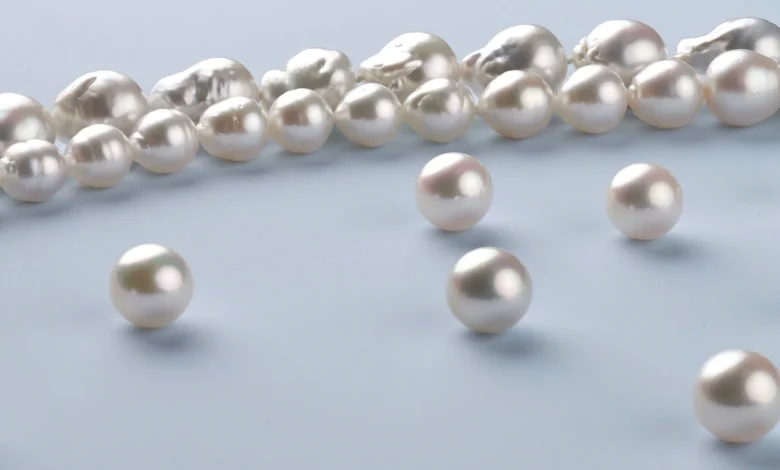South Sea Pearl vs. Other Pearls: What Makes Them Unique?

What gemstone would be better than pearls to captivate a woman instantly? Jewellery lovers have their eyes on pearls and dream of having the best pearl sets in their collections. Pearls, especially a South Sea pearl have been revered for centuries. Not only for its looks but also for its intrinsic and symbolic value, this category of pearls stands out as the most luxurious.
South Sea Pearls & Their Allure
A South Sea pearl is one of the largest and most valuable pearls in the world. They are cultivated in the warm waters of Australia, Indonesia, and the Philippines. The allure and attraction associated with this category of pearls is due to its exceptional characteristics. They are known and cherished for their size, glow, and rare colors. Primarily produced by an oyster called Pinctada maxima – which is much larger than other oysters used to cultivate various types of pearls. The answer to the question “why South Sea pearls are expensive?” lies in the values that they exude. They are popularly known as the “Queen of Pearls” as their unmatched beauty and immense grandeur make them stand out.
How South Sea Pearls Differ
The difference between South Sea pearls and freshwater pearls or other categories is quite stark. Here is a comparison of a South Sea pearl with others based on their values.
Size
One of the most apparent differences among the various types of pearls is their size.
- South Sea Pearls – These pearls approximately range from 9mm to 20mm in size. This property makes them the world’s largest cultured pearls.
- Akoya Pearls – Usually 6mm to 9mm in size, they are smaller but are well-known for their perfectly round shape and high lustre.
- Freshwater Pearls – These often vary between 5mm to 12mm and are considered quite irregular in shape.
- Tahitian Pearls – Tahitian pearls range from 8mm to 16mm and are popular for their dark and exotic colors.
Takeaway – Those wanting to make a statement can choose a South Sea pearl choker or other ornaments due to their impressive size.
Lustre
The lustre of a pearl refers to the way light reflects off the surface. This quality is responsible for the gemstone’s glow.
- South Sea Pearls – A South Sea pearl has a soft, satiny lustre. It is due to the thick nacre. These pearls exhibit a deep and luxurious glow, unlike any other pearl.
- Akoya Pearls – These are known for their high lustrous qualities resembling a mirror. Therefore, they are considered the “classic.”
- Freshwater Pearls – They offer a soft lustre that is less intense as compared to a South Sea pearl or an Akoya pearl.
- Tahitian Pearls – The metallic, almost liquid-y lustre exuded by this category makes them appear dark and mysterious.
Takeaway – Choose South Sea pearls for a rich and luxurious glow with a reflective shine from your jewellery.
Colors
South Sea pearls have naturally arrived in exquisite shades.
- South Sea Pearls – Golden and White South Sea pearls are common. The golden hue radiates warmth and royalty, while their white counterparts symbolize elegance with their creamy sheen. South Sea pearl benefits are also based on the variety of colors.
- Akoya Pearls – They are mostly found in classic white, rose, or silver shades.
- Freshwater Pearls – Freshwater pearls are available in a myriad of colors. The most common hues, however, are white, peach, or lavender.
- Tahitian Pearls – These are the only naturally occurring black-colored pearls. They also come in shades of green or blue.
Takeaway – Golden and White South Sea pearls are unmatched in their beauty.
Thickness of the Nacre
Nacre is the substance that forms the layers of the pearl. The thicker the nacre, the more durable and luminous the pearl.
- South Sea Pearls – A South Sea pearl has the thickest nacre that ranges from 2mm to 6mm. It contributes to their deep glow and longevity.
- Akoya Pearls – These have a thinner nacre and are, therefore, more delicate.
- Freshwater Pearls – These have a thicker nacre but are not as uniform as the South Sea pearls
- Tahitian Pearls – These also have a thicker nacre but the darker colors exude a different lustre as compared to South Sea pearls.
Takeaway – Due to this feature, the South Sea pearl necklace will last for generations, making it a wise investment.
Rarity
These pearls are among the rarest and priciest as their cultivation process is time-consuming. It takes about 2-4 years for these pearls to cultivate, and they are larger.
- South Sea Pearls – South Sea pearl earrings would be highly prized depending on their size and quality.
- Akoya Pearls – They are more affordable and are used in fine jewellery.
- Freshwater Pearls – These are the most budget-friendly.
- Tahitian Pearls – Tahitian pearls are often expensive due to their dark hues but cost less than South Sea pearls.
Conclusion
A South Sea pearl stands out from other pearl varieties due to its exceptional size, lustre, and regally sophisticated look. The timeless statements that this pearl radiates in the different forms of jewellery make them the ultimate choice for aesthetic enthusiasts. South Sea pearls are the true embodiment of elegance and prestige.





